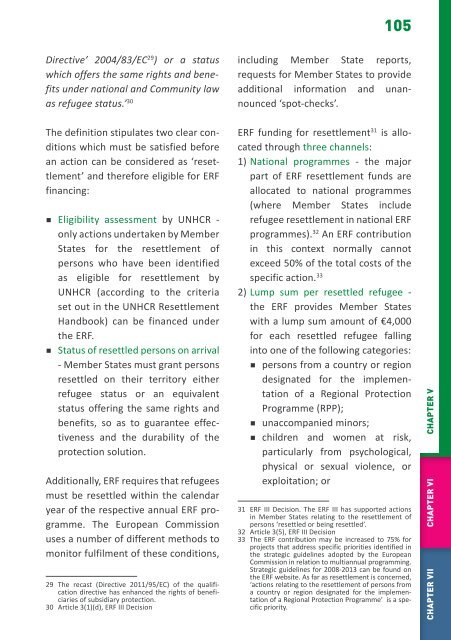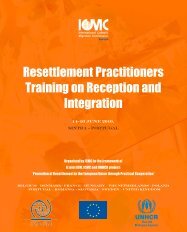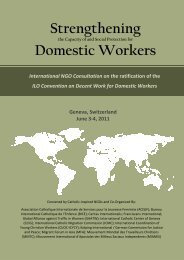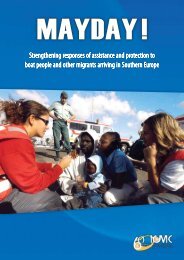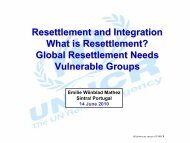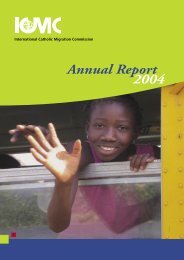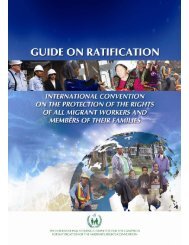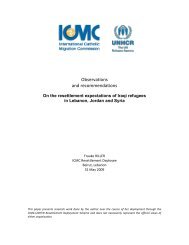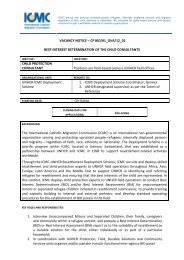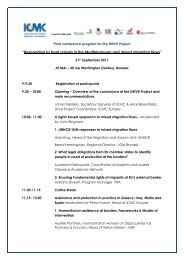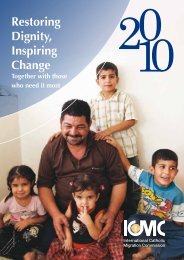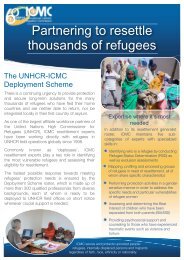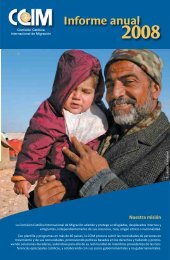ICMCEUROPE WelcometoEurope.pdf (5.89 MB)
ICMCEUROPE WelcometoEurope.pdf (5.89 MB)
ICMCEUROPE WelcometoEurope.pdf (5.89 MB)
Create successful ePaper yourself
Turn your PDF publications into a flip-book with our unique Google optimized e-Paper software.
105<br />
Directive’ 2004/83/EC 29 ) or a status<br />
which offers the same rights and benefits<br />
under national and Community law<br />
as refugee status.’ 30<br />
The definition stipulates two clear conditions<br />
which must be satisfied before<br />
an action can be considered as ‘resettlement’<br />
and therefore eligible for ERF<br />
financing:<br />
• Eligibility assessment by UNHCR -<br />
only actions undertaken by Member<br />
States for the resettlement of<br />
persons who have been identified<br />
as eligible for resettlement by<br />
UNHCR (according to the criteria<br />
set out in the UNHCR Resettlement<br />
Handbook) can be financed under<br />
the ERF.<br />
• Status of resettled persons on arrival<br />
- Member States must grant persons<br />
resettled on their territory either<br />
refugee status or an equivalent<br />
status offering the same rights and<br />
benefits, so as to guarantee effectiveness<br />
and the durability of the<br />
protection solution.<br />
Additionally, ERF requires that refugees<br />
must be resettled within the calendar<br />
year of the respective annual ERF programme.<br />
The European Commission<br />
uses a number of different methods to<br />
monitor fulfilment of these conditions,<br />
29 The recast (Directive 2011/95/EC) of the qualification<br />
directive has enhanced the rights of beneficiaries<br />
of subsidiary protection.<br />
30 Article 3(1)(d), ERF III Decision<br />
including Member State reports,<br />
requests for Member States to provide<br />
additional information and unannounced<br />
‘spot-checks’.<br />
ERF funding for resettlement 31 is allocated<br />
through three channels:<br />
1) National programmes - the major<br />
part of ERF resettlement funds are<br />
allocated to national programmes<br />
(where Member States include<br />
refugee resettlement in national ERF<br />
programmes). 32 An ERF contribution<br />
in this context normally cannot<br />
exceed 50% of the total costs of the<br />
specific action. 33<br />
2) Lump sum per resettled refugee -<br />
the ERF provides Member States<br />
with a lump sum amount of €4,000<br />
for each resettled refugee falling<br />
into one of the following categories:<br />
• persons from a country or region<br />
designated for the implementation<br />
of a Regional Protection<br />
Programme (RPP);<br />
• unaccompanied minors;<br />
• children and women at risk,<br />
particularly from psychological,<br />
physical or sexual violence, or<br />
exploitation; or<br />
31 ERF III Decision. The ERF III has supported actions<br />
in Member States relating to the resettlement of<br />
persons ‘resettled or being resettled’.<br />
32 Article 3(5), ERF III Decision<br />
33 The ERF contribution may be increased to 75% for<br />
projects that address specific priorities identified in<br />
the strategic guidelines adopted by the European<br />
Commission in relation to multiannual programming.<br />
Strategic guidelines for 2008-2013 can be found on<br />
the ERF website. As far as resettlement is concerned,<br />
‘actions relating to the resettlement of persons from<br />
a country or region designated for the implementation<br />
of a Regional Protection Programme’ is a specific<br />
priority.<br />
CHAPTER VI CHAPTER V<br />
CHAPTER VII


